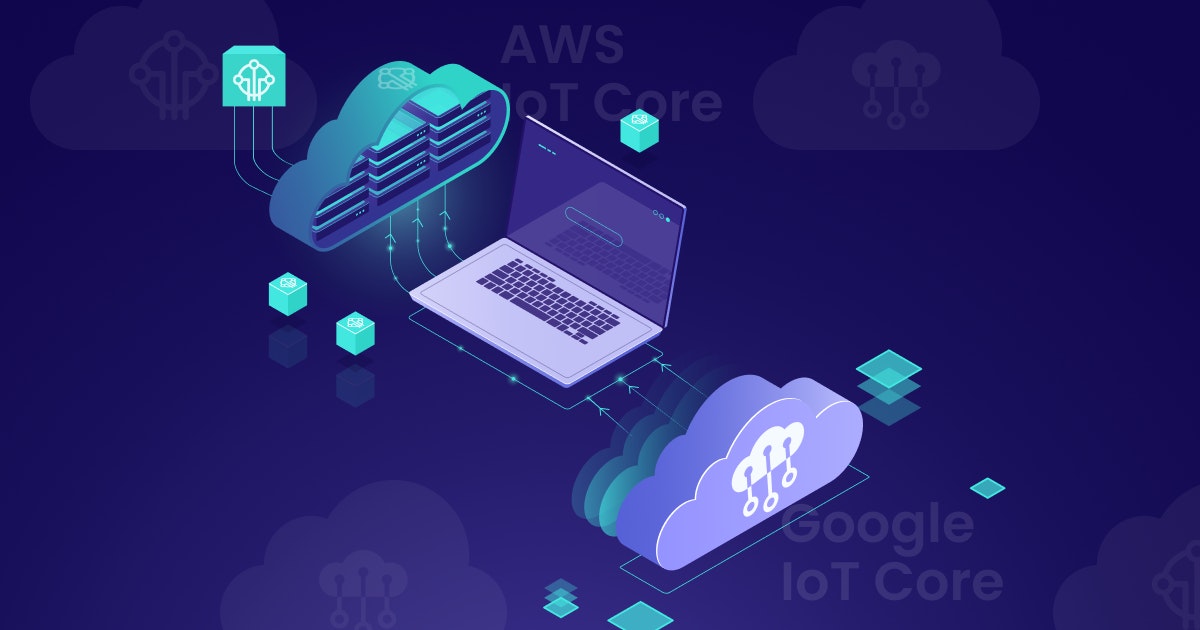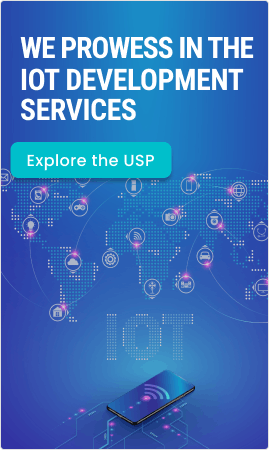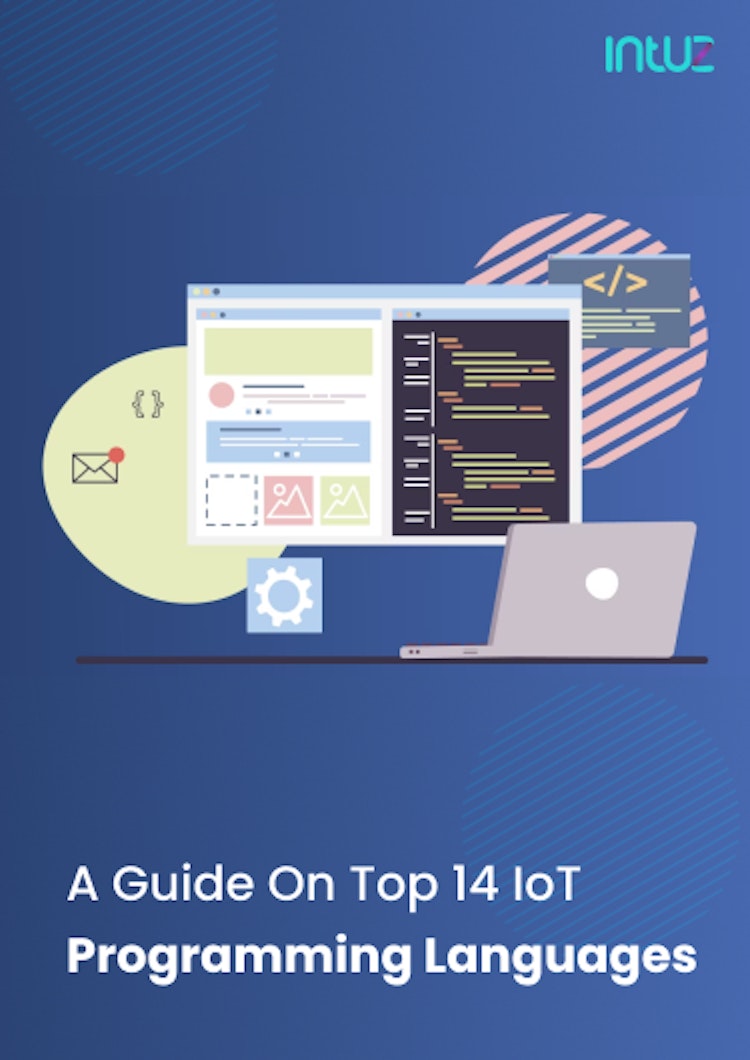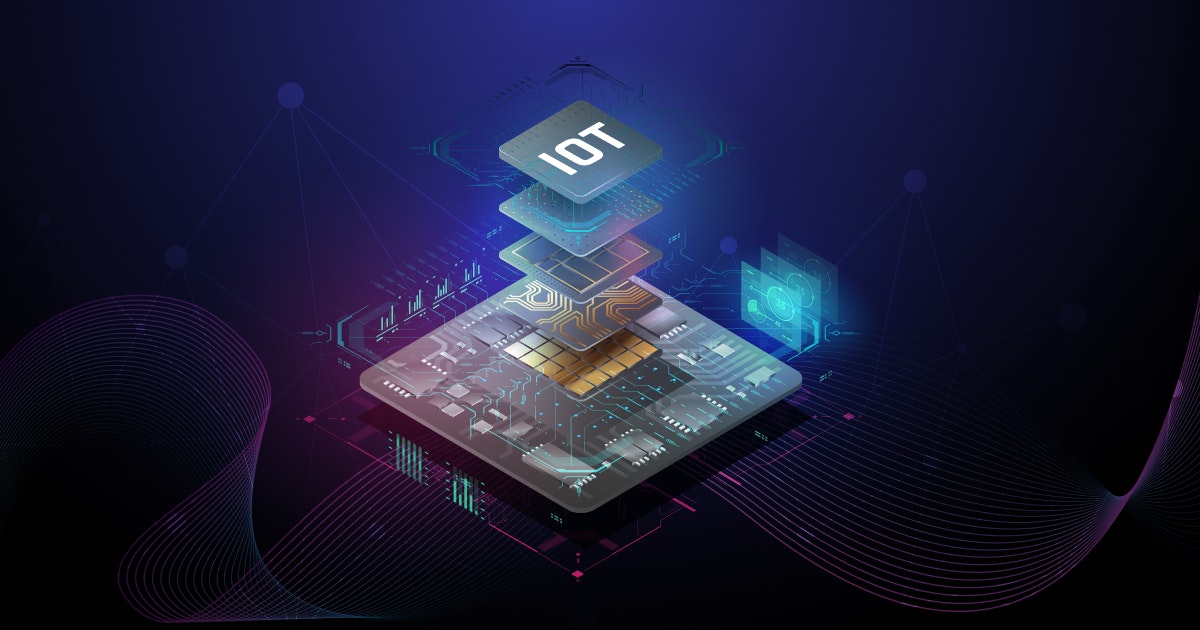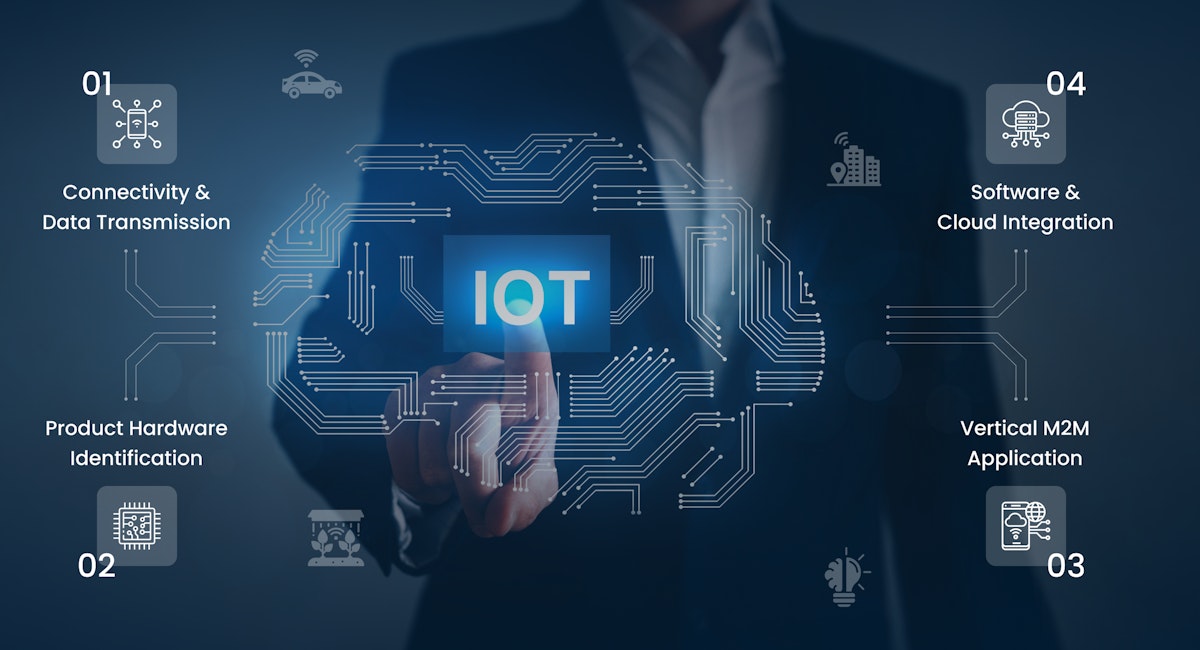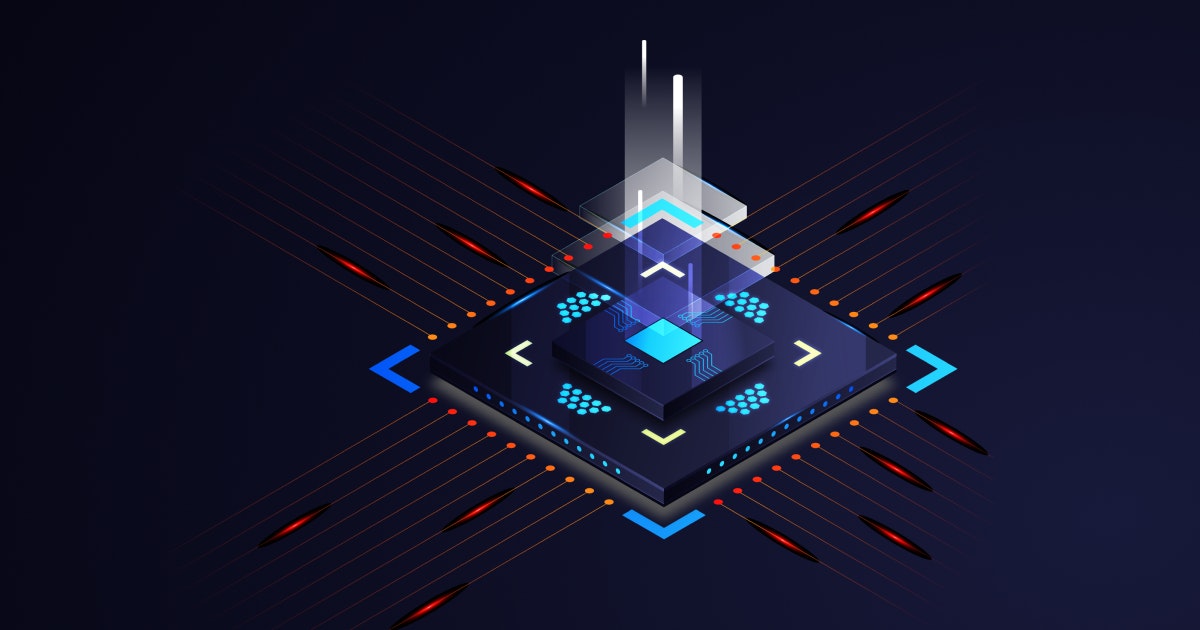Table of Content
The Internet of Things (IoT) ecosystem has evolved rapidly in the past decade with a tremendous increase in the number of IoT-connected devices and data sets. This has resulted in a shift for some customers as they look to upgrade their solutions to meet their business requirements better or transition away from less reliable or scalable platforms.
Over the years, Amazon Web Services (AWS) has helped customers like Belkin, LG, BISSELL, and Traeger Grills quickly migrate from their third-party IoT platforms to AWS IoT to enjoy improved services, better technical support, cost efficiencies, and more.
Pick an IoT-based product and you will find that it can monitor multiple devices, perform hot and cold path analytics, send or receive telemetry data, store or display the data using insights, and send event-based notifications when a particular event occurs.
An IoT device comprises the following features:
- Data storage, processing, and analysis
- Network connectivity
- IoT Sensors
With AWS, one can engineer IoT-based solutions and provide functionalities such as scalability, device maintenance, device monitoring from a single place, and so on. Besides, Amazon can create, manage, and perform several operations on the IoT devices on the cloud.
AWS is Amazon’s cloud computing platform that offers a mix of packaged Software as a Service (SaaS), Infrastructure as a Service (IaaS), and Platform as a Service (PaaS).
It was launched in 2006 to handle online retail operations and has since moved on to high-grade technology, such as the Internet of Things (IoT). Let us take a look at AWS IoT and IoT Core and what it takes to migrate from the latter to the former:
Overview of AWS IoT Core
A managed cloud platform, Amazon IoT Core enables connected devices to effortlessly and securely communicate amongst themselves and with cloud applications. With the ability to accommodate trillions of messages and billions of devices, Amazon IoT Core can reliably process and route messages to other devices and endpoints of Amazon Web Services.
Your apps can monitor and communicate with all of your devices using Amazon IoT. AWS IoT Core is undoubtedly the best among today's cloud integration technologies. AWS, which currently holds a 37% value share in the software market, was recognized as the Best Consumer IoT Solution in 2020 for its effectiveness and dependability.
The Amazon Web Services IoT platform combines more than 200 full-featured services to support projects of any complexity and scale. It is excellent at coordinating networks, connecting billions of devices to the cloud, and securing data.
Owing to its excellent services, the platform is utilized globally by industry giants including Volkswagen, Honda, Siemens, Phillips, LG, and Carrier. It is a favorite among forward-thinking startups and government organizations.
Seamlessly Transition Your IoT Core from Google to AWS with Our Help!
Let's Get StartedGoogle's announcement to discontinue IoT Core services in 2023
Competitors to Google Cloud, including Microsoft and Amazon Web Services, provide comparable IoT services. Customers have time till August 2023 to select a new IoT provider as Google Cloud has stated it will discontinue its IoT services.
According to an update from the Google Cloud IoT Core product team, the service would end on August 16, 2023; meaning access to the IoT Core Device Manager APIs would also be discontinued.
The company has requested customers to switch from IoT Core to another service. In its note, to customers, the company says "We recommend that you take action early to migrate from IoT Core to an alternative service. As an initial step, connect with your Google Cloud account manager if you have questions about your migration plans.”
How does Amazon IoT Core work
Many internet-connected objects like sensors, embedded systems, and software use AWS Cloud to connect and interact. IoT applications gather data, process it, and transmit JSON-format messages on MQTT topics.
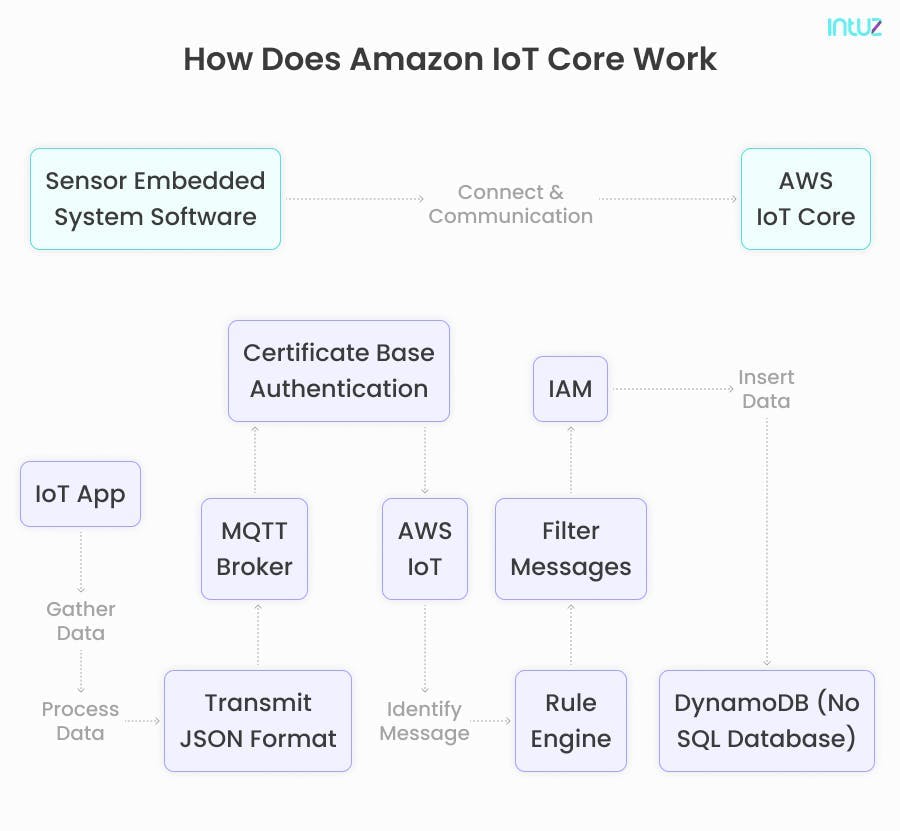
When a device is upgraded, every MQTT may track it. When a message is sent over an MQTT topic, it is forwarded to the MQTT message broker, who then distributes it to users who have subscribed to that subject.
Through X.509 certificates, the communication between AWS IoT and internet-connected devices is protected. To communicate with an AWS IoT device, you must first copy the AWS IoT certificate onto your device where it will serve as a credential.
The register must contain information on every device linked by AWS IoT. The registry typically contains all the information about the certificates needed to work effectively with AWS IoT, such as calling a Lambda function or editing, updating, or deleting a DynamoDB table.
Rules can be created to filter messages and carry out the desired action. The rules engine initiates the action based on the attributes when a specific rule matches the message. Additionally, it has an IAM role that gives AWS IoT access to the resources needed to do the required activity.
Devices can connect to the AWS cloud with the help of AWS IoT. The communication channels that IoT supports are:
- MQTT stands for MQ Telemetry Transport, a simple and lightweight protocol for low-bandwidth devices with unreliable networks. It is made to use less network consumption and fewer resources, which ensures stability and effective message delivery. This supposition benefits machine-to-machine (M2M) and mobile applications where there is high-quality bandwidth.
- The TLS protocol provides a channel for client-server applications to communicate over a network designed to prevent problems like tampering. However, because protocols can function without a TSL, the client must inform the server to establish a TLS connection.
Two approaches are possible for securing a TLS connection. One method is to use a unique port number. The second approach involves using a protocol feature that enables the client to request that the server converts to a TLS connection.
Critical features of AWS IoT Core
With AWS IoT Core, you can connect devices to AWS and other devices, safeguard data and end-user interactions, process and analyze device data, and enable communication within applications even when they are offline. Here are the top features of AWS IoT Core:
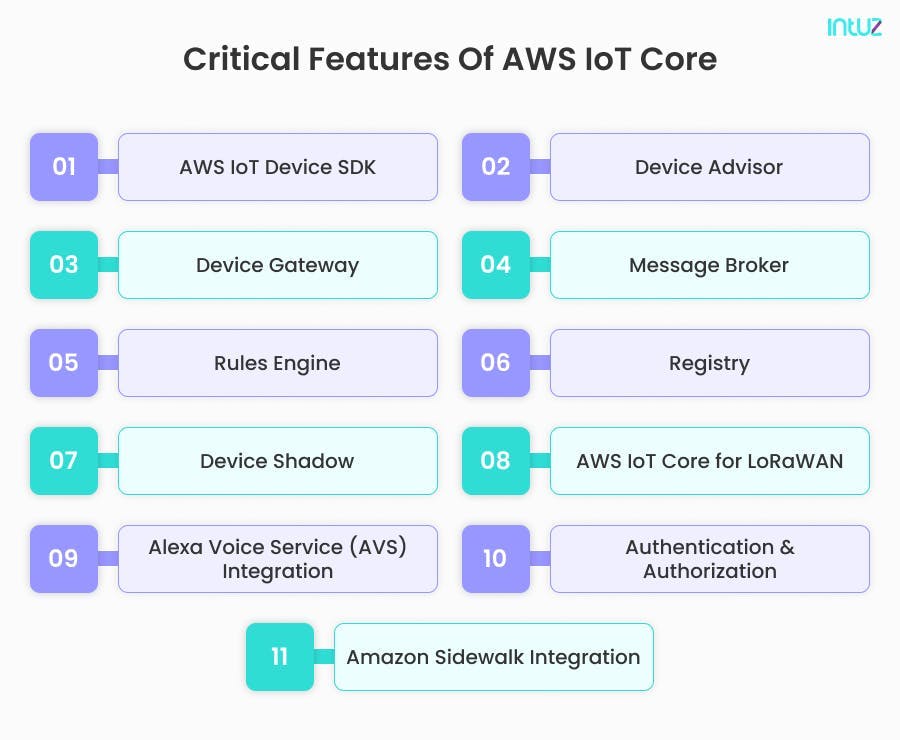
1. AWS IoT Device SDK
You can quickly and easily connect your hardware device or mobile application to AWS IoT Core with the help of the AWS IoT Device SDK. The MQTT, HTTP, or WebSockets protocols can be used by your devices to connect to AWS IoT Core, authenticate, and exchange messages.
2. Device Advisor
Verifying the device's interoperability is crucial. Before deploying devices in production, our AWS specialists can assist you in resolving software-related issues with devices using AWS Device Advisor.
3. Device Gateway
Devices frequently require an interface to send and receive data to and from the cloud. We provide secure connections and semantic implementations for various protocols, including HTTP 1.1, WebSockets, and MQTT.
4. Message Broker
You can send or receive as many messages as you need with Message Broker. Our experts integrate secure communication transfers to the cloud with this capability.
5. Authentication and authorization
AWS IoT Core offers mutual authentication and encryption at all points of connectivity. The tool is used by AWS consultants to produce, distribute, and administer certificates and rules for the devices.
6. Rules engine
A rules engine must be in place to send commands to the devices. You can route messages to AWS endpoints and devices using the AWS rules engine to start a function or rule.
7. Registry
You can keep device-related metadata in the Registry for no extra cost. As long as you view or change your registry entry at least once every seven years, the metadata would not expire.
8. AWS IoT Core for LoRaWAN
Customers can connect wireless devices that employ low-power, long-range wide area network technology using AWS IoT Core for LoRaWAN. It supports Basic Station, an open-source LoRaWAN gateway-LNS communication protocol, so no bespoke gateway software must be written or tested to link LoRaWAN gateways to AWS IoT Core.
9. Amazon Sidewalk Integration
Offering enhanced connectivity, Amazon Sidewalk is a shared network that improves the performance of connected devices. Sidewalk is run by Amazon at no cost to consumers. Integrating Amazon Sidewalk makes it easier to set up new devices, increase the range at which low-bandwidth devices can operate, and keep devices connected even when they are not within the range of your home Wi-Fi. With Amazon Sidewalk Integration, you can quickly onboard your Sidewalk device fleets to AWS IoT Core.
10. Alexa Voice Service (AVS) integration
Devices having a microphone and speaker that are part of the Alexa Built-in category were developed using the Alexa Voice Service (AVS). With the AVS Integration, you can quickly bring distinctive, voice-forward products to market and scale your business to hundreds of millions of Alexa Built-in devices. Media retrieval, audio decoding, audio mixing, and state management are moved from a physical device to a new virtual Alexa Built-in device in the cloud thanks to the AVS Integration for AWS IoT Core.
11. Device Shadow
You can store the state of your devices for no charge with the Device Shadow for up to a year. If you update the Device Shadow at least once every year, it will never expire. Device Shadow provides constantly accessible REST APIs, making creating applications that communicate with your devices simpler.
Top AWS components
An Availability Zone or AZ is a location with numerous physical data centers. A nexus of AZs inter-connected by network links with low latency is required when setting up virtual machines and replicating data. This helps build a reliable infrastructure that avoids failure of the data center or servers. Adding to that thought, here are primary AWS components you must know about:
1. Program tools
- FreeRTOS - An Open Source operating system with an MIT license widely used on small peripherals. It is offered without charge and comes with a core and a vast array of libraries that can be used to connect to AWS IoT Core and many other services.
- IoT Greengrass - This is a cloud-based edge runtime for developing, deploying, and managing devices Any language and compression method are acceptable for program deployment.
- Device tester - Your device will be tested for its capacity to run FreeRTOS in the cloud and communicate with other services using the microcontroller test automation tool.
- SDK for IoT devices - The software development kit's primary function is to aid in connecting devices directly. The Open Source libraries make it simple to implement on already-existing hardware.
2. Control elements
- IoT Core - Connectivity to the Cloud Core Service strengthens the bandwidth to handle multiple connections while securing communications quickly.
- AWS IoT Device Manager - This offers a practical means of controlling and managing system activities. Connected devices can be registered individually or in groups. Additionally, you may send OTA updates, track functionality, and troubleshoot problems.
- Device Defender - It promises to safeguard your machine completely from all problems. A managed service regularly checks device behavior and configurations and guards against misuse or hacking.
- IoT 1‑Click - It enables one-click execution of AWS Lambda operations on essential devices. Devices can track resources, update goods and services, and provide notifications to technical help.
3. Data
- IoT Analytics - Without a native analytics platform, data IoT analytics enables the execution of detailed evaluations of massive amounts of data. IoT analysis allows you to utilize new items with more accuracy.
- AWS IoT Wise website - This asset is responsible for gathering, organizing, and analyzing data from industrial equipment. The site simplifies routing and expedites the detection and repair work of sensor issues.
- Events - These are data patterns that can identify changes in equipment condition. Events enable you to choose data sources, specify the logic for each event, and decide whether to display a warning or take the default action in each situation. To quickly address issues that develop, the service automatically reacts to events depending on the logic you provide.
- Things IoT Graph - It offers a Graphical User Interface (GUI) for modeling-based interaction customization. Things IoT Graph allows you to drag and drop components to configure how devices and web services interact.
Start with a Well-Scrutinized Digital Transformation Strategy
Learn MoreThe seamless migration of IoT Core (AWS) from Google Cloud IoT Core
Whether there is an opportunity for your company to build your IoT solution from scratch or move your existing product on AWS IoT Core, AWS offers a variety of alternatives to assist you in migrating:
1. IoT platform migration ideation workshops run by AWS IoT Partners can assist you in defining your migration objectives. They can help you choose targets with obvious paths to production, and ensure business owners are on board.
2. IoT migration discovery and design workshops by AWS Professional Services are multi-day events to help you design your Proof of Concept (PoC) and migration plan. These workshops employ a methodology based on internal best practices developed by Amazon over years of experience.
3. Based on AWS's experience moving thousands of business customers to the cloud, the Migration Acceleration Program is a thorough and tested cloud migration program. It provides low-cost tools to automate and accelerate execution.
Additionally, the program provides AWS promotional points and other incentives for migration projects that meet specific criteria.
4. AWS Solutions-Focused Immersion Days are hands-on learning experiences with AWS products and services. AWS aids in the development of the skills required to create, deploy, and operate your infrastructure and applications in the cloud.
Benefits of AWS IoT Core migration
Significant improvements in security, accessibility, interoperability, and scalability are the main advantages of moving to the AWS IoT platform. Apart from this, some additional benefits of switching to AWS IoT Core include:
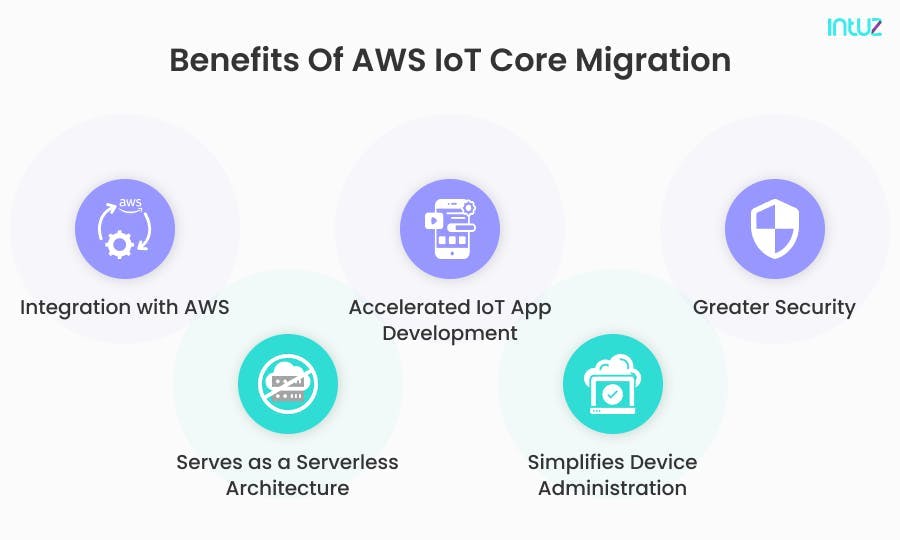
1. Accelerated IoT app development
Thanks to AWS IoT Core, you can create reliable IoT applications that let you control all of your connected devices from a single location. It brings significant cost and time savings while reducing the complexity of development and speeding up the process to shorten the time to market.
2. Serves as a serverless architecture
By lowering costs, creating a serverless application can assist your business in managing a distant server or set up a server of your own. Additionally, it provides quick accessibility across many IoT devices while giving you complete control over your application. With a serverless application design, server maintenance does not hinder your critical business processes.
3. Integration with AWS
The AWS IoT Core platform's support for integration with other AWS products during AWS IoT Core development is one of its most notable advantages. It is simple to use several Amazon cloud services, including AWS CloudTrail, AWS Lambda, Amazon Simple Storage Services (S3), Amazon DynamoDB, Amazon QuickSight, Amazon Kinesis, and even Alexa Voice services.
4. Greater security
Data security is a critical problem for every corporation that integrates IoT into its business processes. Your company data needs to be protected with strong security standards to stop cyberattacks. However, AWS IoT Core provides the highest level of security for data flows between connected devices and apps.
5. Simplifies device administration
You may safely connect a growing number of devices to the cloud and other devices with AWS IoT Core. Additionally, it enables you to design an easy-to-use application interface to securely and privately manage connected devices and their data from a central location.
Maximize Your IoT Performance with AWS!
Talk to ExpertsOver to you
We understand that migrating to a new IoT platform is not easy for any business - regardless of the budget, project size, and industry vertical. Thankfully, certified AWS partners and/or IoT app development experts can do all the heavy lifting for you and help implement a successful migration strategy aligned with your primary business requirements.
Book a Free 45-minute Consultation with Our IoT Experts Today! Get a customized roadmap and strategies to migrate your IoT Core from Google to AWS IoT infrastructure.
